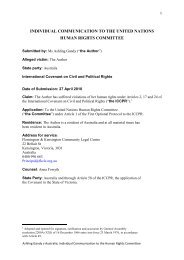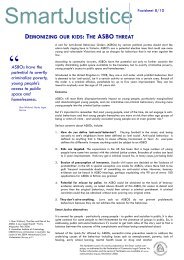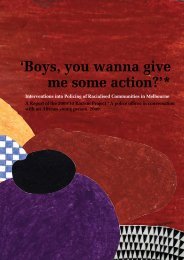Reducing Ethnic Profiling in the European Union - Open Society ...
Reducing Ethnic Profiling in the European Union - Open Society ...
Reducing Ethnic Profiling in the European Union - Open Society ...
- No tags were found...
Create successful ePaper yourself
Turn your PDF publications into a flip-book with our unique Google optimized e-Paper software.
people were stopped and valuable police resources wasted. However, us<strong>in</strong>g <strong>the</strong> moreelaborated suspect description that <strong>in</strong>cluded <strong>the</strong> suspects’ heights and cloth<strong>in</strong>g showedproper use of good <strong>in</strong>telligence.Investigations of transnational organized crime and terrorism are usually largerand more complex than ord<strong>in</strong>ary crim<strong>in</strong>al <strong>in</strong>vestigations, but <strong>the</strong> basic elements of<strong>in</strong>telligence are not fundamentally different. The ma<strong>in</strong> difference is that fight<strong>in</strong>g transnationalorganized crime and terrorism requires <strong>in</strong>telligence-shar<strong>in</strong>g and cooperationbetween <strong>the</strong> law enforcement agencies and <strong>in</strong>telligence services of different countries,and this cooperation is beset by challenges. It is not uncommon for members of crim<strong>in</strong>algangs to have <strong>the</strong> same nationality or ethnic background (although <strong>the</strong>y are alsoknown to recruit from outside <strong>the</strong>ir group <strong>in</strong> order to avoid known ethnic profiles).Border guards and customs officers often develop profiles that <strong>in</strong>clude <strong>the</strong>se factors toguide <strong>the</strong>ir efforts to combat transnational crime. Such uses of ethnicity, national orig<strong>in</strong>,and o<strong>the</strong>r personal factors are entirely legitimate as long as <strong>the</strong>y are based on reliableand up to date <strong>in</strong>telligence, and are used <strong>in</strong> a properly targeted fashion.The follow<strong>in</strong>g case study shows <strong>the</strong> importance of us<strong>in</strong>g <strong>in</strong>telligence <strong>in</strong> determ<strong>in</strong><strong>in</strong>gstops and searches. Specifically, it illustrates how one law enforcement agency’sshift from focus<strong>in</strong>g on superficial characteristics such as national orig<strong>in</strong> to a more<strong>in</strong>telligence-driven approach resulted <strong>in</strong> fewer—but more effective—stops and searches.UNITED KINGDOMEnd<strong>in</strong>g <strong>Ethnic</strong> <strong>Profil<strong>in</strong>g</strong> Enhances EffectivenessIn 1998, 43 percent of searches that <strong>the</strong> US Customs Service performed were on blacksand Lat<strong>in</strong>os, although blacks and Lat<strong>in</strong>os made up a much smaller proportion of alltravelers. A particularly large number of searches, <strong>in</strong>clud<strong>in</strong>g highly <strong>in</strong>vasive x-raysand strip searches, were carried out on Lat<strong>in</strong>a and black women suspected of be<strong>in</strong>g“drug mules” based on a profile that relied heavily on nationality and ethnicity. The hitrates for <strong>the</strong>se searches was low across all groups: 5.8 percent for whites, 5.9 percentfor blacks, and 1.4 percent for Lat<strong>in</strong>os; and was particularly low for black and Lat<strong>in</strong>awomen, who were <strong>in</strong> fact <strong>the</strong> least likely to be carry<strong>in</strong>g drugs on or <strong>in</strong> <strong>the</strong>ir bodies.In 1999, Customs changed its procedures, remov<strong>in</strong>g race from factors to consider<strong>in</strong> mak<strong>in</strong>g stops and <strong>in</strong>troduc<strong>in</strong>g observational techniques focus<strong>in</strong>g on behaviorssuch as nervousness and <strong>in</strong>consistencies <strong>in</strong> passenger narratives, us<strong>in</strong>g more <strong>in</strong>telligence<strong>in</strong>formation, and requir<strong>in</strong>g closer supervision of stop-and-search decisions.By 2000, <strong>the</strong> racial disparities <strong>in</strong> <strong>the</strong>se searches had nearly disappeared. The numberof searches carried out dropped by 75 percent, and <strong>the</strong> hit rate improved from lessthan five percent to over 13 percent, and became almost even for all ethnic groups. 188REDUCING ETHNIC PROFILING IN THE EUROPEAN UNION 105
















